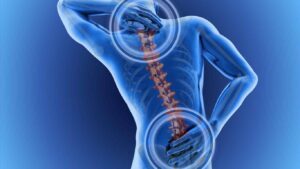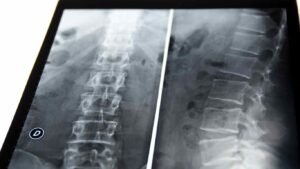Will an MRI tell me why I have Back Pain?
By APA Sports & Exercise and Musculoskeletal Physio, Rick Bain

Wouldn’t you love to have xray vision?
To look deep inside someone’s anatomy & skin & diagnose their problem(s) immediately, with amazing accuracy?
It is a lovely thought; however, we all live in the ‘real world’. As physio’s, we have a love-hate relationship with imaging (Xray, MRI, CTscan, Bonescan, Ultrasound and more) when it comes to back pain. Primarily because they produce ‘false-alarms’.
MRI is an amazing technology, providing clear visualisation of the body’s tissues. This can be invaluable in the right situations. However, with great power, comes great responsibility; and its power is not being wielded appropriately when it comes to low back pain.
We all generally accept more and more wrinkles as we get older. But just like the wrinkles on the outside, we also get ‘wrinkles’ on the inside in the form of degenerative changes of our discs and joints. In fact, our spines usually look worse on scans than they are.
Research after research has demonstrated a high percentage of “problems” on spinal MRI in people without symptoms. For example, one such study reported 30% of 20-year olds and 60% of 50-year olds have “disc bulging”, and 37% of 20-year olds and 80% of 50-year olds have “disc degeneration” in people without any symptoms.
So, what we have learnt is that Diagnosing someone’s low back pain mainly on imaging findings is usually misleading.
 Low back pain is extremely multifactorial, and the ‘wrinkles’ found on MRI imaging are only one small piece of the low back pain puzzle. Factors such as activity levels, weight, lifestyle, mental health, even whether you smoke or not, are known to be much more important factors impacting low back pain than those horrible sounding, yet often innocuous findings on MRI.
Low back pain is extremely multifactorial, and the ‘wrinkles’ found on MRI imaging are only one small piece of the low back pain puzzle. Factors such as activity levels, weight, lifestyle, mental health, even whether you smoke or not, are known to be much more important factors impacting low back pain than those horrible sounding, yet often innocuous findings on MRI.
Physio’s have long understood that you simply cannot reliably diagnose low back pain with MRI in isolation, and the ‘false alarms’ they produce can often do more harm than good. Sounds scary to be told “you have disc bulging or degeneration at L3,4 levels”, right? Unless this fits with the person’s clinical picture, these “false alarms” may lead to stress/anxiety, fear of movement and activity, and longer-term reduced mobility and deconditioning, leading some people into a cycle of low back pain.
This is not a new issue.
Clinical guidelines for the management of low back pain produced by the American College of Physicians and American Pain Society in 2007 stated that “it is strongly recommended that Physicians avoid using MRI and Xray for low back pain unless it is ‘really rather bad’”. ‘Really rather bad’ refers to persistent and severe neurological symptoms, spinal cord involvement, or non-musculoskeletal causes such as cancer. In these situations, MRI can be an absolute blessing.
This same message has been published and re-published in clinical guidelines ever since. Clearly it is a slow message to get through. When we see clients presenting to us in clinic with acute low back pain, and their GP or other health professional has performed premature imaging, it can be a hard sell to educate them on the relevance of their scan. Especially when they have been provided a diagnosis by their GP based on imaging findings by a radiologist who interprets imaging without the context of the client presentation, so without knowing your symptoms and testing your presentation and what you can/can’t do. There are only few occasions when early imaging helps the initial stages of low back pain management.
Are you a ‘glass half empty or half full’ person?
 Here is a test. When your physio tells you, “Your scan does not assist in diagnosis”, do you think “nobody can tell me what’s wrong with me”, “OMG, I have degeneration, I wont be able to work ever again”;
Here is a test. When your physio tells you, “Your scan does not assist in diagnosis”, do you think “nobody can tell me what’s wrong with me”, “OMG, I have degeneration, I wont be able to work ever again”;
OR, do you think “I’m happy to hear that my MRI shows no concerning changes and what was reported by the radiologist are just normal findings in most scans”?
Your ability to understand the true nature of your low back pain and to trust in the rehabilitation pathway & guidance provided by your Physio is greatly impacted by whether you are a ‘glass half full or half empty’ kind of person.
 If you are not sure whether you require or warrant further imaging, our physiotherapists are well placed to assess and help guide you. If you have recent MRI’s for your low back pain and feel this article challenges everything you (thought) knew about the results, feel free to consult with us and we will be happy to shed unbiased, accurate light on your individual scenario.
If you are not sure whether you require or warrant further imaging, our physiotherapists are well placed to assess and help guide you. If you have recent MRI’s for your low back pain and feel this article challenges everything you (thought) knew about the results, feel free to consult with us and we will be happy to shed unbiased, accurate light on your individual scenario.
Phone 07 55006470 or Book Online for an appointment with our experienced Gold Coast Physio Team.

































